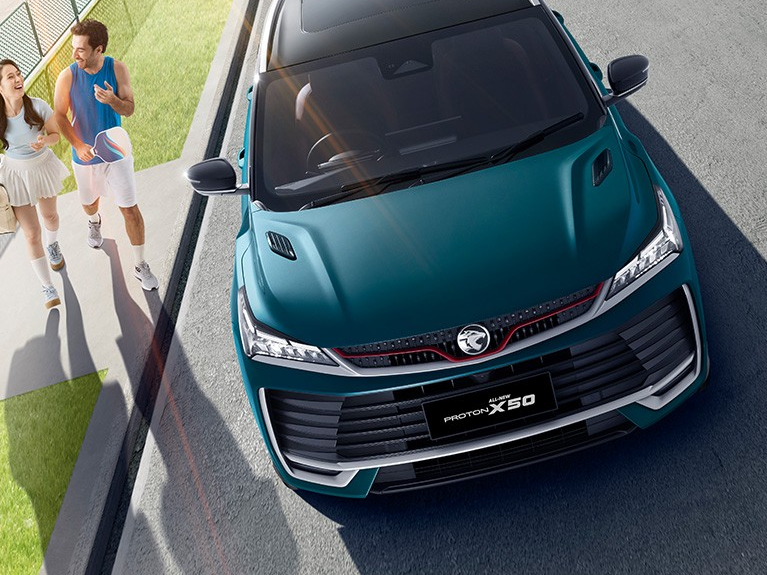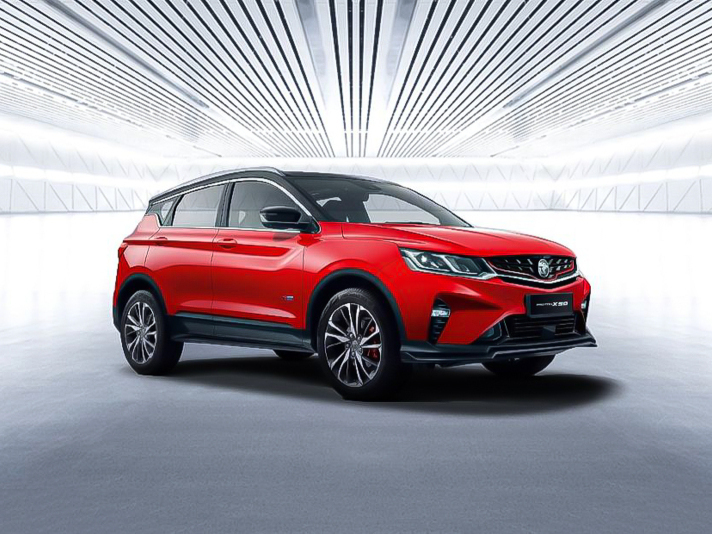Q
proton x50 how many seater
The Proton X50 is a 5-seater compact SUV that's right at home with Malaysian families or daily commuters. Its seats strike a nice balance between comfort and space – the back row can fit three adults, though for longer drives, the middle seat is better suited for a child to keep things comfy all around. Sure, it's technically a five-seater, but they've smartly optimized the space. Flip those rear seats down in a 60:40 split, and suddenly you've got way more cargo room, perfect for hauling groceries or packing up for a quick weekend getaway.
Now, why does this matter? Well, five-seater SUVs are big news in Malaysia, and for good reason. They’re practical, the road tax is easier on the wallet compared to seven-seaters, and they’re generally more fuel-efficient – all things local buyers really value. The X50 steps it up further with standard safety tech like ADAS, which really cements its family-friendly vibe. If you’re dead set on more space, Proton’s got you covered with seven-seat options like the X70. Just remember, bigger size can sometimes mean a little less nimbleness in your day-to-day drive – something to think about!
Special Disclaimer: This content is published by users and does not represent the views or position of PCauto.
Related Q&A
Q
How much horsepower does the X50 Turbo have?
The Proton X50 Turbo is powered by a 1.5-liter three-cylinder turbocharged engine that cranks out 177 horsepower and a peak torque of 255 Nm. This engine features direct fuel injection and is mated to a 7-speed dual-clutch transmission, delivering pretty impressive performance—especially suited for Malaysian city driving and highway overtaking needs. What's worth noting is that the X50 Turbo's engine is tuned to emphasize low-end torque, so you get that nice, punchy power response in everyday driving, and it's relatively fuel-efficient too. For Malaysian buyers, the X50 Turbo's powertrain setup is pretty competitive in its SUV class, and with local assembly, the price becomes even more appealing. If you're craving more performance, keep an eye on the X50 Flagship variant, which bumps the horsepower up to 181 and comes with a fancier suite of driver assistance systems. Malaysia's hilly terrain and hot climate really put a car's powertrain to the test, but the X50 Turbo's cooling system and transmission tuning have been optimized for these conditions, ensuring reliable long-term use.
Q
How much is Proton X50 in Singapore?
The Proton X50 retails for around SGD 100,000 to SGD 120,000 in Singapore, with the exact price depending on the trim level and dealer promotions. Thanks to Singapore's high car import taxes and Certificate of Entitlement (COE) costs, it's significantly pricier than in Malaysia. For Malaysian buyers, the X50 goes for about MYR 80,000 to MYR 110,000 locally, offering much better value for money.
Under the hood, it's packing a 1.5-liter turbocharged engine that delivers solid power and fuel efficiency—perfect for city driving. If you're planning to buy one in Singapore, make sure to look into the local COE policies and loan options first, since these can really impact the total cost.
Plus, the Proton X50 has a solid reputation in Southeast Asia, especially when it comes to safety features and tech. Definitely worth checking out.
Q
What is the engine of Proton X50?
The Proton X50 is powered by a 1.5-liter turbocharged direct-injection (TGDI) three-cylinder engine, co-developed by Proton and Geely. This engine comes in two tuning versions: the standard variant delivers 150 horsepower and 225 Nm of torque, while the Flagship trim ups the ante to 177 horsepower and 255 Nm. It's mated to a 7-speed dual-clutch transmission (DCT), striking a balance between performance and fuel efficiency.
Under the hood, the engine borrows technology from Geely's BMA modular platform, featuring lightweight construction and direct fuel injection. These advancements help keep fuel consumption in check and ensure compliance with Malaysia's stringent EURO 4 emission standards. A notable point is that Proton has tweaked the engine specifically for local conditions – think a cooling system and ECU calibration optimized to handle our hot and humid weather. Plus, owners can run it on RON 95 petrol, which helps keep day-to-day running costs down.
For Malaysian buyers, small-displacement turbo engines like this have been gaining traction as the market favorite in recent years. Compared to traditional naturally aspirated engines, they deliver more torque at lower revs, making them well-suited for city driving. While three-cylinder setups do involve a slight trade-off in terms of smoothness, the use of a balance shaft has significantly reduced vibration issues. What's more, maintenance costs are on par with those of four-cylinder engines.
Q
Will the X50 facelift have a new engine?
As for whether the facelifted X50 will get a new engine, there's no official word yet. But looking at Proton's usual update strategy, facelifts typically focus more on tweaks to the exterior, interior, and features. The engine is likely to stay the same: the existing 1.5T three-cylinder turbo setup. It's proven itself reliable in the Malaysian market, and with its fuel efficiency plus 147hp/226Nm output, it fits the B-segment SUV bill. If you're craving more power, keep an eye out—Proton might roll out a high-performance variant or a hybrid model down the line. After all, the global trend is going electric, and local brands are also ramping up their new energy tech game. Best bet is to check Proton's official website or local Malaysian auto media for the latest scoop. And a quick tip for car buyers: beyond just power figures, factor in real-world stuff like maintenance costs and after-sales network. At the end of the day, the long-term ownership experience is what really matters.
Q
Which country made Proton X50?
The Proton X50 is a compact SUV co-developed and produced by Malaysian national automaker Proton and China's Geely. Its manufacturing base is located in Tanjung Malim, Perak, Malaysia. Based on Geely's Binyue platform, the model has undergone several localized adaptations for the Malaysian market, including right-hand drive configuration, safety features compliant with local regulations, and an air conditioning system tailored for tropical climates. The Proton X50 is powered by a 1.5-liter turbocharged engine and offers multiple driving modes, balancing performance with fuel efficiency. As a key strategic model for the Proton brand, the X50 has gained popularity among Malaysian consumers thanks to its high value for money and rich technological configuration, such as the advanced driver assistance system (ADAS) and smart connectivity features, further solidifying Proton's competitiveness in the local market. Notably, the collaboration between Proton and Geely has not only enhanced the technical content of the X50 but also driven the upgrading of Malaysia's automotive industry chain, with increasing local production ratios creating more job opportunities and facilitating technology transfer locally.
Q
Is the Proton X50 engine a VOLVO?
The Proton X50's engine isn't directly sourced from Volvo. Instead, it's built based on the modular architecture technology co-developed by Geely and Volvo. Its 1.5-liter three-cylinder turbocharged engine is part of the "Drive-E" powertrain family jointly developed by Geely and Volvo, but Geely took the lead in tuning it to suit Malaysian market needs. This engine incorporates some of Volvo's technical patents, such as direct fuel injection and lightweight design, though the production line and supply chain are independently managed by Geely's system. It's worth adding that the X50's powertrain has undergone local adaptation, including cooling system optimizations for tropical climates and adjustments for RON95 gasoline compatibility, which differ from the calibration of Volvo's original engines. Malaysian owners will notice Geely badges in the X50's engine bay rather than Volvo logos, but the technical origins do reflect the synergy following Geely's acquisition of Volvo. This kind of technology-sharing model is common in the automotive industry – for example, multiple brands under the Volkswagen Group also share engine platforms, which helps reduce R&D costs while ensuring core performance.
Q
Is the X50 a good car to buy?
The Proton X50 is an SUV that Malaysian consumers should definitely consider. It offers solid value for money and competitiveness in the local market. Under the hood, it's powered by a 1.5-liter turbocharged engine, available in two power tunes: the standard variant puts out 150PS, while the performance version cranks it up to 177PS. Both are mated to a 7-speed dual-clutch transmission, delivering smooth power delivery and decent fuel efficiency—perfect for city commutes and long drives alike.
The X50 doesn't skimp on features either. It comes loaded with goodies like Advanced Driver Assistance Systems (ADAS), a panoramic sunroof, a digital instrument cluster, and smart connectivity functions, which really shows Proton's commitment compared to its rivals. Plus, as a homegrown brand, Proton has an edge with its after-sales service network and parts availability, keeping maintenance costs relatively low—something Malaysian buyers definitely care about.
Of course, before making a purchase, it's always a good idea to take it for a test drive to see if the suspension setup and noise insulation meet your personal taste. You might also want to check out competitors like the Honda HR-V or Toyota Corolla Cross, then pick the one that best fits your budget and needs. All in all, the X50 strikes a nice balance between performance, features, and price, making it especially appealing to young families looking for a tech-savvy and practical ride.
Q
What are the common Proton X50 problems?
The Proton X50, a popular B-segment SUV in the Malaysian market, delivers a well-rounded performance overall, though some owners have reported a few common issues. For instance, certain models may exhibit slight jerking from the dual-clutch transmission (DCT) during low-speed driving – a characteristic typical of this transmission type. It’s advisable to stick to regular maintenance and avoid prolonged low-speed creeping to optimize the experience. Additionally, a small number of users have mentioned occasional lag or freezing with the infotainment system, which can be resolved through software updates at official service centers. When it comes to noise insulation, there’s still room for improvement at highway speeds, with tire noise being particularly noticeable; upgrading to quieter tires later might help mitigate this. Notably, the 1.5T three-cylinder engine in the Proton X50 performs better than expected in terms of vibration control, though it’s recommended to keep an eye on engine mount aging after long-term use. The standard Advanced Driver Assistance System (ADAS) has also seen continuous optimization through OTA updates for better local adaptation, so owners should ensure their systems are up to date. Overall, most of these issues are common across the segment, and Proton’s extensive after-sales network – with 140 service centers nationwide – means owners can get support when needed. Regular maintenance and timely software updates go a long way in enhancing the driving experience.
Q
How much is the Proton X50 2024?
The 2024 Proton X50's prices in Malaysia vary by trim level. The entry-level Standard variant starts at around RM86,300, while the top-spec Flagship model goes for approximately RM113,300. Exact pricing may fluctuate slightly depending on optional configurations or promotional offers. As a best-selling SUV from Malaysia's homegrown brand, the Proton X50 is powered by a 1.5-liter turbocharged engine available in two tunes, delivering 150PS and 177PS respectively. It comes packed with advanced driver assistance systems like adaptive cruise control and lane keeping assist, making it a hit among young families and urban commuters for its strong value proposition. It's worth noting that the X50 shares its technical platform with the Geely Binyue but has been localized for Malaysian roads and consumer preferences – the suspension setup, for instance, prioritizes comfort while still maintaining decent fuel efficiency. The warranty package, offering 5 years with unlimited mileage, is another plus for buyers mindful of long-term ownership costs. If you're in the market for a compact SUV, head to an authorized dealer for a test drive. It's also a good idea to compare it with segment rivals like the Perodua Ativa or Honda HR-V to pick the one that best fits your budget and needs.
Q
What is the fuel consumption of the X50 2025?
Let's talk about the 2025 Proton X50's fuel efficiency. Official figures tell us the 1.5T Standard variant sips around 6.4 liters per 100km in mixed driving, while the 1.5T Flagship nudges up slightly to about 6.7L/100km. Of course, real-world numbers can vary a bit depending on how you drive, the roads you take, and how much you're carrying.
Under the hood, that 1.5-liter turbo engine paired with the 7-speed dual-clutch gearbox does a solid job on fuel economy – it's well-suited for both Malaysian city commutes and highway stretches. If you're keen to squeeze even more km out of each liter, stick to smooth driving habits: avoid jackrabbit starts and sudden stops. Regular maintenance helps too – keeping an eye on tire pressure and swapping out the air filter when needed are simple tweaks that can really boost efficiency.
What's impressive is how this B-segment SUV strikes a nice balance between fuel sipping and performance. It's no wonder the X50 remains a top pick for Malaysian buyers who want something that's easy on the wallet and practical for daily use.
Popular Cars
Model Year
Car Compare
Car Photo
Latest Q&A
Q
Why is gasoline a fuel?
Gasoline can serve as a fuel because it possesses core properties suitable for providing power and the ability to convert energy. It is a hydrocarbon mixture obtained through fractional distillation and cracking of petroleum, mainly containing C5-C12 aliphatic hydrocarbons, naphthenes, and a small amount of aromatic hydrocarbons. It is characterized by volatility and flammability, with low viscosity facilitating smooth flow in injection systems, and rapid evaporation enabling quick formation of a uniform combustible mixture with air. Gasoline stores chemical energy; when ignited by a spark plug in the engine combustion chamber, it burns rapidly to release a large amount of thermal energy, which pushes the piston to move and converts into mechanical energy, providing power for vehicles such as cars and motorcycles. In addition, the anti-knock property of gasoline (measured by octane number) can adapt to engines with different compression ratios, ensuring stable operation and performance; it has a high energy density, storing more energy per unit volume, good combustion efficiency, and high availability of gas stations for convenient use. Therefore, it has become the main fuel for spark-ignition internal combustion engines and is widely used in transportation and related fields.
Q
What are 1st, 2nd, and 3rd family gases?
The first, second, and third family cars are vehicle categories classified based on the stages of family car-purchasing needs. The first family car is an entry-level economical model, such as the Perodua Axia and Proton Saga, priced at approximately 30,000 to 50,000 Malaysian ringgit. It emphasizes fuel efficiency and practicality, making it suitable for young families purchasing a car for the first time. The second family car falls into the mid-range category, offering more space and enhanced features, such as the Proton Persona and Toyota Vios, priced between 60,000 and 100,000 Malaysian ringgit, catering to the comfort requirements of growing families. The third family car is a premium model or an MPV/SUV, such as the Proton Exora and Honda CR-V, priced above 100,000 Malaysian ringgit. It boasts spacious interiors and upscale configurations, ideal for larger families or long-distance travel. Malaysian consumers typically prioritize fuel efficiency, maintenance costs, and space when selecting a vehicle. Families at different life stages adjust their car choices accordingly. For instance, small families may begin with the first category, upgrade to the second after having children, and larger families often opt for the third category.
Q
What are the four types of natural gas?
Natural gas can be classified into four main types based on its source: gas field gas (pure natural gas), associated petroleum gas, condensate field gas, and coalbed methane. Gas field gas is directly extracted from gas wells, typically containing over 90% methane with minimal impurities. Associated petroleum gas is a byproduct of oil extraction, containing not only methane but also significant amounts of other hydrocarbons such as ethane and propane. Condensate field gas yields light hydrocarbon fractions during extraction, characterized by a high methane content and small quantities of heavier hydrocarbons like pentane. Coalbed methane is extracted from underground coal seams, primarily consisting of methane and nitrogen, and must have a methane content exceeding 40% to be utilized as fuel. Due to compositional differences, these natural gas types vary in calorific value and applications. The first three are commonly used for urban gas supply, whereas coalbed methane requires purification before effective utilization. As a clean and efficient energy source, the development and utilization of these diverse natural gas types play a crucial role in optimizing energy structure.
Q
What are the three types of fuel gas?
Common fuel gases are mainly divided into three types: natural gas, liquefied petroleum gas (LPG), and manufactured gas. Natural gas is a flammable gas existing in nature, with methane as its main component. It is colorless and odorless, leaves no residue after combustion, and has high thermal efficiency, making it a clean energy source. Liquefied petroleum gas is a by-product of the petroleum refining process, whose main components include propane and butane. It is a gas at room temperature but can be converted into liquid through pressurization and cooling, facilitating storage and transportation. Manufactured gas is generated through thermochemical reactions of fossil fuels such as coal or petroleum under specific conditions, with main components including hydrogen, carbon monoxide, and methane. It has low production costs but produces certain pollution after combustion, so ventilation should be ensured during use. These three fuel gases have different application scenarios in the energy supply field, and their calorific values and usage characteristics also vary. For example, the calorific value of natural gas is approximately 33,000-36,000 kcal per cubic meter, that of LPG is about 90,000 kcal per kilogram, and that of manufactured gas is roughly 3,500-4,200 kcal per cubic meter. The different calorific values make them suitable for different energy demand scenarios such as households and industries.
Q
Is unleaded petrol a gas?
Unleaded gasoline is not a gas but a liquid fuel. It refers to gasoline with a lead content of less than 0.013 grams per liter and without the addition of tetraethyl lead as an anti-knock additive during the refining process. Its octane rating is typically 95, slightly lower than the 97 of leaded gasoline. The use of unleaded gasoline can effectively reduce emissions of harmful substances such as hydrocarbons, carbon monoxide, and nitrogen oxides in vehicle exhaust, thereby lowering pollution risks including smog, toxic gases, and acid rain. However, it should be noted that while unleaded gasoline contains no artificially added lead, it still retains trace amounts of lead from crude oil. Additionally, its combustion releases gases, particulate matter, and condensates, with particles smaller than 2 microns in diameter being particularly prone to prolonged suspension in the air and subsequent human inhalation. Thus, potential health impacts remain a concern. Currently, most vehicles can use unleaded gasoline directly, though certain models require selecting the appropriate octane grade as recommended by the manufacturer to ensure optimal engine performance and longevity.
View MoreRelated News

Proton X50 meets its true competitor? A comprehensive comparison with Chery Omoda 5
AshleyDec 24, 2025

The all-new Proton X50 has sold over 6,000 units in a month and a half since its launch, becoming the champion in its segment.
RobertSep 18, 2025

2025 Proton X50 launched for 5 days and has received 8,000 orders, with 999 units delivered
RobertAug 1, 2025

2025 Proton X50 Facelift Debuts with New 1.5L Four-Cylinder, Priced from RM89,800
AshleyJul 28, 2025

Proton X50 Interior Revealed: A Practical Space Designed for Young Drivers
LienJul 3, 2025
View More

















Pros
Cons